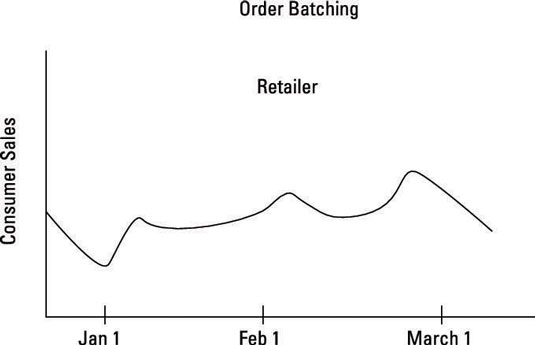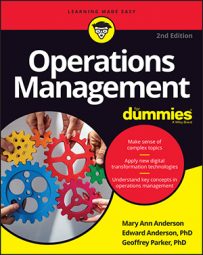The bullwhip effect exists in all supply chains — it’s the root of the boom and bust cycles that occur in many operations — and it can be devastating if not properly managed. Fortunately, you have ways to manage the bullwhip and minimize its impact. The bullwhip effect is triggered by several different causes. Here are four of the most prevalent causes.
Delivery delays and pipeline inventory
Delivery delay, also called lead time, is the span of time between when an order is placed and when it’s received. If you don’t maintain sufficient inventory, you need to account for the time it takes your suppliers to produce and/or deliver goods.
For example, consider a beer supply chain in a city hosting the Super Bowl for the first time. During the week before the game, end customers purchase the beer from a local retailer. By Tuesday, when supplies of beer on the shelf get low, the retailer places an order with the wholesaler.
When the wholesaler receives the order from the retailer, it prepares the beer for shipment and ships it. Processing the order and delivering it to the customer take time. This time is considered the delivery delay.
While the order is being shipped, the retailer continues to sell beer; as stock disappears, the retailer orders even more beer from the wholesaler on Thursday. The wholesaler in turn experiences a decrease in inventory and places additional orders with the brewers.
The factory, located in Germany in this case, has a long lead time to ship the beer, which may inspire the wholesaler to order even more beer as inventory decreases in order to avoid empty shelves in other cities.
The greater the delivery delay, the more prone your supply chain is to the bullwhip effect because orders increase across the supply chain as everyone waits for delivery. If all participants in the supply chain don’t account for the pipeline orders and continue to order normally as inventory is depleted, when the ordered shipments start arriving, the participants will end up overshooting their desired inventory levels and decrease future orders.
This leads to large variation in demand experienced throughout the supply chain.
Be sure to modify the basic inventory equations to include orders that have been placed but not received by customers. For example, in a periodic inventory review system, the amount of inventory that a firm should order is revealed by this formula:
Amount to Order = Demand Lead Time + Safety Stock – Amount on Hand – Amount on Order
Order batching
Depending on how frequently you order from your supplier, your supply chain will likely experience varying levels of bullwhip effect. Placing frequent orders for small quantities is better (creates less bullwhip) than placing larger orders less frequently. The demand is continuous (not constant) over the month, and the retailer places orders with its supplier once per month. This creates very inconsistent demand for the supplier over time.

The demand stream to the supplier can be smoothed if, instead of once a month, the retailer places an order to the supplier every week.
Sales and price discounts
Many supply chain experts believe that promotional price discounts and sales are the worst marketing ploys ever created when it comes to managing a supply chain. When things you regularly use and buy go on sale, a bullwhip effect often occurs because sales create a boom-and-bust cycle. Lots of product moves during the promotional period, which is followed by lower levels of sales. This cycle ripples through the supply chain.
Promotional sales also lead to retail outlets running out of inventory, which means that customers hoping to purchase the product on sale can’t get it. If offered, customers can wait in line at the customer service counter to receive a rain check for the product, but in most cases, customers leave disappointed, with a lower opinion of the operation.
Another unintended consequence of promotional sales, especially if a company offers them frequently, is that customers come to expect a sale, and they won’t purchase items unless they’re on sale. Companies also believe that they must offer the sales to attract customers.
Shortage gaming
Shortage gaming occurs when customers place multiple orders for a product with one or more suppliers or when they place an order for more than what they want. Customers often do this if they know inventory will be in short supply.
Consider the release of a hot new product such as a video game. You know you must have it the day it’s released to the public and realize that it may be in short supply. So you place a preorder with several retailers, knowing that you’ll purchase only one and will cancel orders from the others.
This double or phantom ordering creates a false demand picture for the product provider. Demand can often be exaggerated, leading the producer to increase output. This very real problem occurs often in businesses where shortages are expected, and the effect ripples throughout the supply chain. Many companies, especially those in the retail industry, have tried to combat this by making the customer place a small deposit on ordered items.

